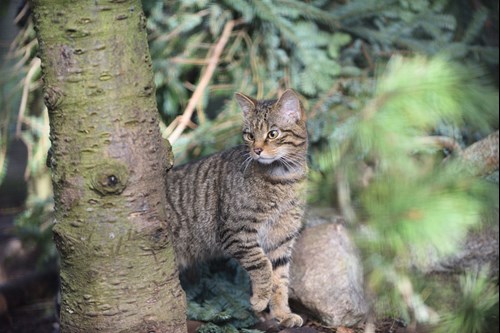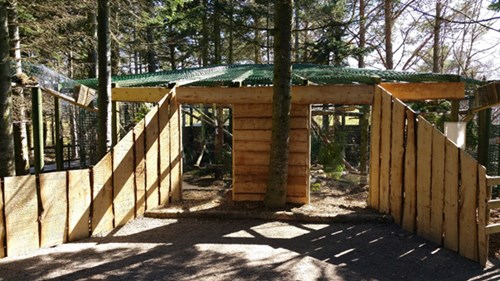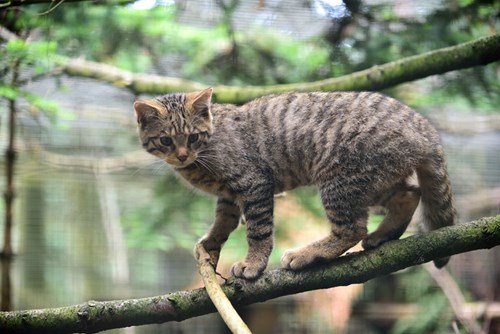Cat Conservation Blog: Breeding Success at Highland Wildlife Park
21/04/2016 in Conservation
Announcing new births to the public is always an exciting time for those of us who work in zoological collections. The animal keepers work tirelessly throughout the year ensuring animal enclosures are clean, complex, enriching and refurbished on a regular basis to provide new stimuli for the animals that will encourage the full repertoire of natural behaviours.

One of the 2015 kittens now as a juvenile (RZSS/A.Riddell, 2016)
On top of this there are daily visual health checks, animal training and a varied, natural diet that ensures the animals are not only in great physical condition but their welfare is paramount, which all play a key role in future successful breeding. As we move through April and into May (the main birthing season for wildcats), keepers wait eagerly for any subtle changes in behaviour that give the first indication of any females that may give birth.
As any zoo manager will tell you, the breeding of any small cat species is challenging and should collections have success then this is usually down to the skill, experience and setup of any given zoological institution. Looking back over the last few years at the track record of breeding carnivore species at the Highland Wildlife Park, it is clear to see that the animal department and its staff are not only highly experienced but completely focused on the welfare and husbandry of all its animals. Although there have been regular breeding successes with the Amur tigers, European wolves, European lynx, Pallas’s cats (regarded as the most challenging small cat species to breed) and, more recently, the wolverine, we should look at specifically at the Scottish wildcat given our breeding for release strategy.

New on-show Scottish wildcat enclosure at the Highland Wildlife Park (RZSS/D.Barclay 2016)
As the Scottish wildcat studbook coordinator I can tell you first hand from studbook data that in the last five years there have been 17 wildcat kittens born at the Highland Wildlife Park. Of these 17 kittens two have since died, one after being transferred to another collection and one earlier this year following a routine health check where it was found that it had a congenital defect in the form of a hepatic shunt.
It is always a sad occasion when any new born animal doesn’t make it, but knowing that routine health checks and screenings allow us to address any health issues quickly and effectively is reassuring. Importantly, the breeding success rate at the Highland Wildlife Park with Scottish wildcats over the last five years sits at 88%, something that all staff should be proud of.
Since the six wildcat births in 2015 (five of which are still surviving), there have been a number of developments here at the Park as we constantly strive to enhance the facilities and population for this iconic native species. A third enclosure has since been built to provide more space, choice, separation areas (if needed), public viewing and den sites. This enclosure, like the others, is interconnected by overhead walkways, which not only provide unique viewing for the public, but more importantly raised vantage points for the cats, which they make full use of.
In addition to these changes, we have since exchanged a breeding male with Aigas Field Centre to ensure that both collections can continue breeding through different blood lines, increasing the genetic diversity of the population. Given that this male is unrelated to our females, he will be given the choice to mate with one of our adult females and her daughter from 2015 over the next twelve months.

One of the kittens back in 2015 (RZSS/A.Riddell, 2015)
Other transfers include two of the males from 2015 that were moved to Alladale Wilderness Reserve, where they have each been successfully introduced to separate unrelated females with the aim of future breeding. The final two kittens from 2015 (now juveniles), one male and one female, are still housed at the Park and will soon be sent off to other zoological collections where they too will be paired with unrelated animals for future breeding.
It is important to mention, however, that despite the impressive breeding successes at the Park, the wildcat captive studbook and breeding programmes cannot function through one collection alone. Instead, it is the collaboration and joint efforts of all Scottish wildcat holders throughout the UK that make it what it is. Through population management, animal exchanges, research, conservation support and education, Scottish wildcat holders are not only safeguarding this critically endangered native species, they are playing their role in a conservation strategy that gives new hope to the future of wild living Scottish wildcats.
Featured Articles

An update from the Budongo Forest
19/04/2024 in Conservation

Edinburgh Zoo named best zoo in Scotland
15/04/2024 in Edinburgh Zoo
Latest News
-
News

27/03/2024
HRH The Princess Royal visits project to restore wildcats to Scotland
HRH The Princess Royal visited the Saving Wildcats project, based at the Royal Zoological Society of Scotland’s (RZSS) Highland Wildlife Park, to learn more about the partnership project working to save one of the UK’s most endangered carnivores.
-
News

13/10/2023
Critically endangered wildcats now call the Cairngorms National Park home
The first round of wildcat releases in Scotland has been completed by Saving Wildcats, led by the Royal Zoological Society of Scotland (RZSS) in partnership with NatureScot, Forestry and Land Scotland (FLS), The Cairngorms National Park Authority, Nordens Ark and Consejería de Sostenibilidad, Medio Ambiente y Economía Azul de la Junta de Andalucía.
-
Blog

24/07/2023
What’s on the menu for the European wildcats
European wildcat is a secretive species, and so it is difficult to observe their hunting and feeding behaviour in the wild. Analysing their scats is an alternative way to find out what they eat and therefore how they fit into the ecosystem. RZSS WildGenes scientists developed a technique to detect DNA of different prey species in scat samples.
-
News

22/06/2022
Ten more wildcat kittens born at Saving Wildcats conservation breeding for release centre
Keepers at the Saving Wildcats conservation breeding for release centre have captured images of one of two new litters of wildcat kittens, who could be among the first of their species to be released into the wild in Britain.

























Follow EZ